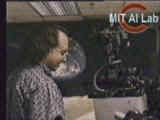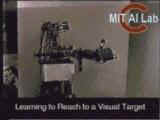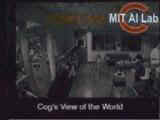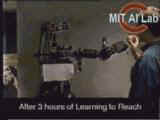|
General Footage
The Cog Shop
MIT Artificial Intelligence Laboratory
545 Technology Square, #920
Cambridge, MA 02139
|
|
The latest video footage of Cog and Kismet as of 2/19/99.
Cog:
Kismet:
This video consists of interviews with several members of the Cog group demonstrating
and discussing their most recent work. To view an accompanying article and alternate
formats visit a page on cog at MIT Video
Productions.
This clip shows some 1995 footage of Cog interacting with Prof. Rod
Brooks. The robot is attending to visual motion, and orienting its head and neck toward
that motion. The arm and hand motion shown in this clip are simple repetitive motions
which are not interactive.

One of the large sensori-motor integration tasks that has been implemented on Cog so
far is the ability to reach to a visual target. Cog learns this task by trial and error.
The first video clip shows the robot attempting to reach to where it is looking without
any learning. Notice that the hand and eyes end up in very different positions.

Each time the robot attempts to reach for a target and fails, it learns from that mistake.
By waving its hand, the robot is able to determine the point that it actually reached
toward, and can make an incremental refinement based on that error signal. This learning
process is documented in the SAB-96 paper Self-Taught
Visually-Guided Pointing for a Humanoid Robot by Marjanovic, Scassellati, and
Williamson. The second video clip shows the images from the robot's camera during one
training trial. The high speed change in camera position is the saccade that marks the
beginning of the trial. After that, you can see the arm start to move. While the arm is in
motion, we fade to the motion detection and grouping display, to show how the robot finds
the arm within the visual field.

The final clip shows the robot reaching to visual targets after approximately 3 hours of
self training. After training, the robot was instructed to reach towards any moving
object. This clip shows the robot reaching for a toy ball that is being waved in front of
it. Notice that the hand reflexes are not yet integrated with the reaching behavior, so we
need to place the ball into the robot's hand.

|



